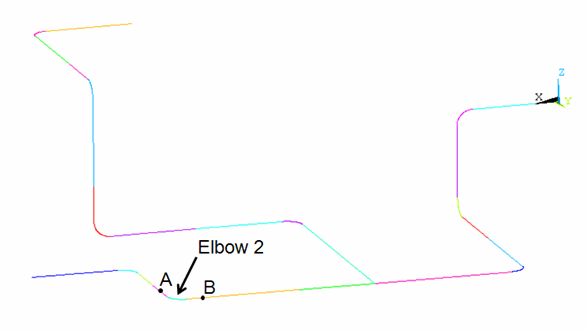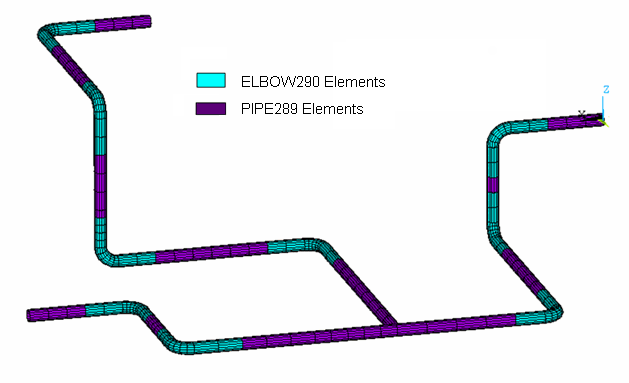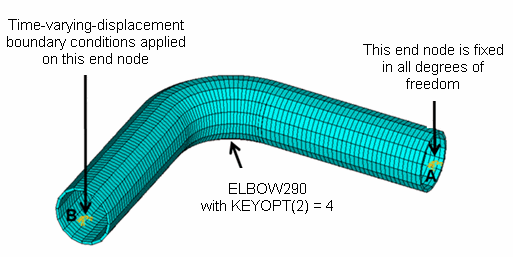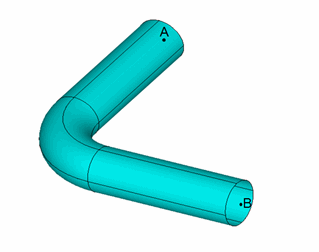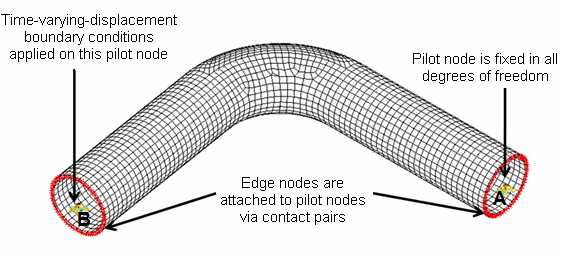Three models are prepared for this problem:
The entire piping system is examined in this model. Initially, a line diagram of the piping system is created:
Straight segments are meshed with PIPE289 elements, and elbows are meshed with ELBOW290 elements:
An ELBOW290 element key option controls the level of accuracy in cross-sectional deformation. In this case, KEYOPT(2) = 4 allows general section deformation, including nonuniform radial expansion, ovalization, and warping.
The average diameter and average thickness of the pipes are assigned to ELBOW290 and PIPE289 elements (via SECDATA and SECTYPE commands), as follows:
SECTYPE,1,PIPE
SECDATA,Do,T ! Where Do is the outer diameter and T is thickness of the pipe
! In this example, Do = 219.2 mm and T = 10.38 mm
SECNUM,1 Subsequently, to create necessary transition zones from the elbows to straight-pipe segments, the ELBOW command automatically converts a few PIPE289 elements adjacent to the elbows into ELBOW290 elements, as follows:
ELBOW,ON,,,Elbow and pipe elements must have the same pipe section ID for the pipe-to-elbow transition to occur.
A modal analysis is performed on the global model to obtain the fundamental natural frequency. The result is compared to the experimental result.[1]
8.3.2. Local Elbow Model Meshed with ELBOW290 Elements
The local nonlinear analysis is focused on the elbow between locations labeled A and B in Figure 8.2: Entire Nuclear Piping System Line Diagram.
Following is the line diagram of this elbow model:
The model has branches that are 645.2 mm long and an elbow with a radius of 304.8 mm (for a total centerline length of 950 mm). The diameter of the pipe is 219.2 mm and the wall thickness is 10.38 mm. The elbow is meshed with ELBOW290 elements:
Time-varying-displacement boundary conditions, extracted from a transient analysis of the entire piping system model under seismic loading, are applied at one end of the model. A nonlinear static analysis using the Chaboche material model is performed on this elbow model to obtain the stress and strain response over time.
8.3.3. Local Elbow Model Meshed with SHELL281 Elements
An equivalent local 3D model of the same elbow using SHELL281 elements is used to generate a reference solution. The 3D surface representation of the elbow and the refined SHELL281 mesh are shown respectively in the following figures:
Material properties and loadings considered in this model are identical to those of the local ELBOW290 model. A conversion of boundary conditions from the global line mesh to the local 3D shell mesh is necessary, however. Time varying displacement boundary conditions are applied to the pilot node at one end of the model. The pilot nodes are coupled with edge nodes at both ends via contact elements as shown in Figure 8.7: Elbow Model Meshed with SHELL281 Elements.



